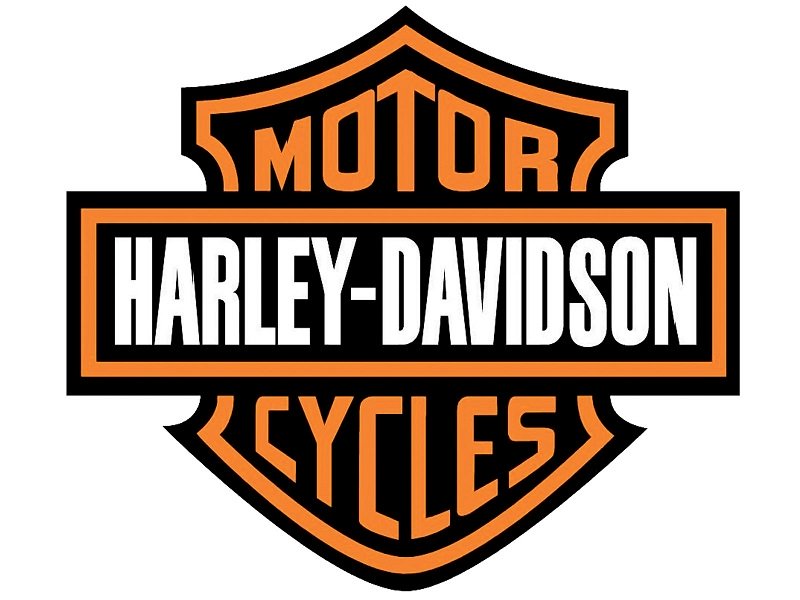Harley WLA History
Article by Mark Trotta
During World-War-Two, nearly all Harley-Davidson motorcycle production was for military use. Several different models were produced, but the vast majority was the WLA Flathead 45, which saw use in every theater of military operation.
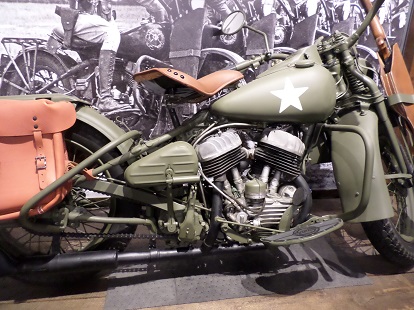
Harley Military Bike Development
As war in Europe escalated, the United States saw their odds of being pulled into a second World War increasing. Starting in 1939, the U.S. government began allocating money to build up all phases of their military.
_________________________________________________
_________________________________________________
The military began testing motorcycles from several different manufacturers, most notably Harley-Davidson and Indian. Among the requirements were that the motorcycle be capable of 65 miles-per-hour and not overheat at low speeds.
Military vs Civilian Models
Early prototype models were essentially the same as civilian Harley 45 models, with front forks lengthened slightly to increase ground clearance. Add-ons included crash bars, skid plates, cargo rack and saddlebags.
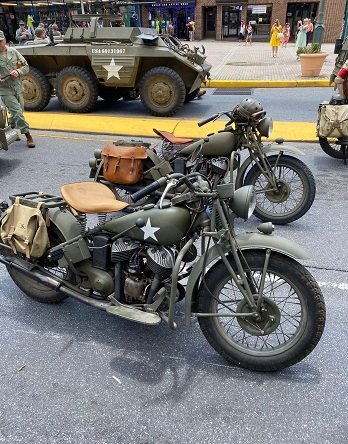
2024 WWII Weekend, Mid-Atlantic Air Museum, Reading, Pennsylvania
On military models, the sides of fenders were trimmed back to prevent mud-clogging on unpaved roads. Headlights and taillights were changed from the civilian model to meet military standards.
Some were fitted with front and rear blackout lights to reduce night-time visibility.
WLA Designation
The letters WLA stand for; "W" indicating 45ci flathead, "L" for high compression, and "A" for Army use.
Engine Compression Ratio
Here in the 21st century, it's hard to believe that 6.0:1 was once considered a high compression motor, but the reader must remember that modern high-octane fuel and high compression engines came after (and were actually by-products) of WW2.
The U.S. Army specified a slightly lower compression ratio ( 5.0:1) than civilian WL's, allowing them to run on lower quality fuel. Although this decreased power output, it made for easier starting (all bikes were kick-start only).
Oil-bath air filters were fitted to reduce dust from dirt roads. All WLA engines were fitted with aluminum cylinder heads.
*********************
Harley WLA Engine Specs
- Configuration: V-Twin
- Engine Displacement: 742cc (45 cubic-inches)
- Bore and Stroke: 2.75" x 3.18"
- Compression ratio: 5.0:1
- Electrical System: 6 Volts
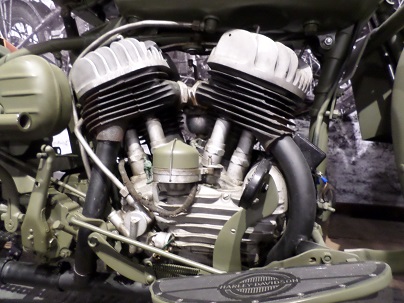
*********************
40WLA and 41WLA
After passing requirements and testing, the U.S. Army initially ordered about 400 Harley WLA models. These early examples have a VIN starting with "40WLA". The following year brought the 41WLA.
42WLA
Within the first few months of America entering the war, the 41WLA evolved into the 42WLA. These would be manufactured for the next four years, up until August 1945. The 42WLA models encompass the vast majority of WLA bikes produced.
_________________________________________________
_________________________________________________
All WLA motors produced in 1942, 1943, 1944, and 1945 have a VIN starting with "42", regardless of what year they were built. This was unique in the Motor Company's history, and presumably done to simplify paperwork.
Accessories
Military accessories included luggage rack, ammo box, and leather rifle scabbard. WLA models were also equipped with D-shaped foot-boards.
*********************
From the factory, military-bound motorcycles were fitted with Firestone Sportsman 4.00-18 tires. With few exceptions, all WW2 bikes were painted flat olive drab.
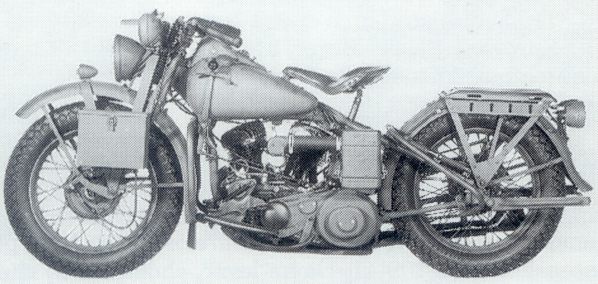
Picture Courtesy Harley-Davidson
*********************
Harley WLC
Harley-Davidson produced a Canadian version of the WLA called the WLC (the 'C' standing for Canada). Differences from the American model included a foot shift/hand clutch, and other modifications requested by the Canadian Army. About 18,000 WLC's were produced for WW2, with some of these going to the United Kingdom and Australia.
*********************
Lend Lease
Along with trucks, tanks, airplanes, and ships, motorcycles were supplied to ailing countries through Lend Lease Agreements. Nearly 60 percent of WLA production (over 34,000) were exported under Lend-Lease and other military assistance programs.
*********************
Harley WLA In Action
Being big and bulky, the WLA did not have the maneuverability of Britain's smaller motorcycles, nor the off-road capability of German motorcycles, but it's rugged simplicity proved just right for messenger service.
Although WW2 Army Jeeps proved to be more versatile, quite often motorcycle dispatch riders were the fastest way to send orders too secret for wireless transmission.
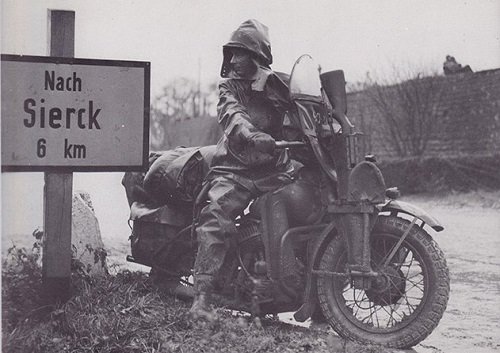
Picture Courtesy U.S. Army
In every theater of operation they were sent to, Harley WLA's reliably transported fully-equipped soldiers with gear and supplies. They were also utilized for escort work, convoys, courier duties, and some scouting. Both during and after the war, they appeared in parades and military police functions.
Liberator Nickname
During the war in Europe, the WLA acquired the nickname 'Liberator'. This came about as bikes ridden by U.S. troops "liberated" towns and countries from German occupation. They are also referred to as 'The Motorcycle That Won The War'.
*********************
Excellence Award
The Army-Navy 'Excellence in Production Award' was created in 1942 to recognize industries for outstanding contributions to the war effort. Only industries that participated in wartime production were eligible to receive this high honor.
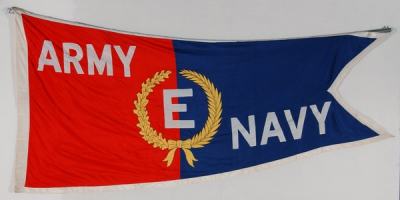
Of the more than 85,000 companies directly involved in the U.S. military's war effort, the award was granted to just five percent of them. The Harley-Davidson WLA received this honor twice; first in 1943 and again in 1945.
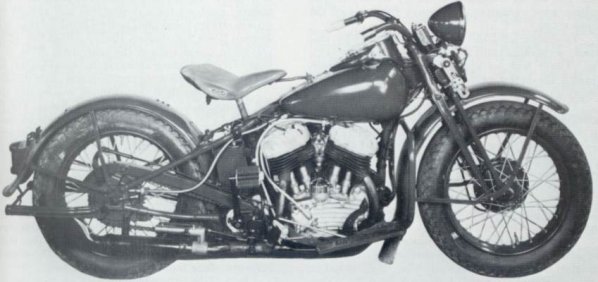
Picture Courtesy Harley-Davidson
Production Numbers
In all, Harley-Davidson produced about 70,000 WLA and WLC military motorcycles during the war years 1941-1945. The largest portion of these (about 27,000) went to the Soviet Union under the Lend Lease program. Spare parts for an additional 30,000 bikes were also produced.
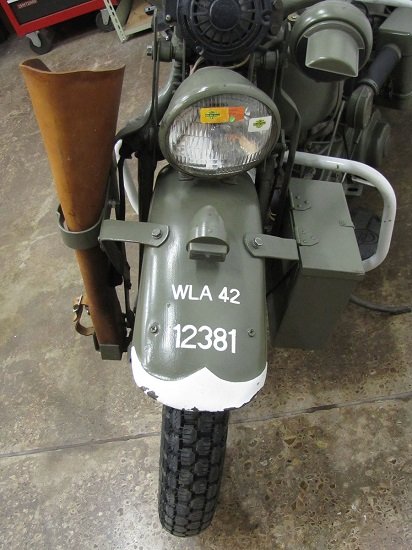
Picture Courtesy National Motorcycle Museum
WLA Motorcycles After WW2 (Europe)
After the war ended, the U.S. military saw no need to transport used motorcycles back to the states. So, along with trucks, tanks, trailers, and other discarded military equipment, many ended up in scrap heaps. One can only guess how many were destroyed, but quite a few survived and adopted by local townspeople.
WLA Motorcycles After WW2 (United States)
At the end of WW2, the U.S. Army sold many unshipped WLA's domestically as military surplus, often at very cheap prices.
Korean War Harley
Production started up again in 1949 and ran through 1952; these bikes were shipped to the Korean peninsula. Some historians note that the WLC was also carried over.
After the Korean War was over, the U.S. Military sold off many military bikes as government surplus, along with spare parts. Many of these surplus bikes were chopped and customized, becoming early choppers and bobbers. Because of this, original examples have become extremely rare, and are quite valuable in today's collector market.
*********************
Harley 45 Serial Numbers
Stamped in the left engine case, civilian Harley 45 serial (VIN) numbers start with the last two digits of the year, followed by the letter designation, then a four-digit assembly sequence code.
Example: 42WLxxxx
Some Harley WLA motors had an additional number in the VIN.
Example: 42WLAxxxxx
Canadian models are stamped "43WLCxxxx"
Although identical in appearance to WW2 Harleys, Korean War WLA's will have a VIN starting with a 49, 50, 51, or 52. By comparison, WW2 models have VIN's that start with a 40, 41, or 42.
*********************
Military Breather Tube
Note the tall breather tube coming out of the front right side of the engine.
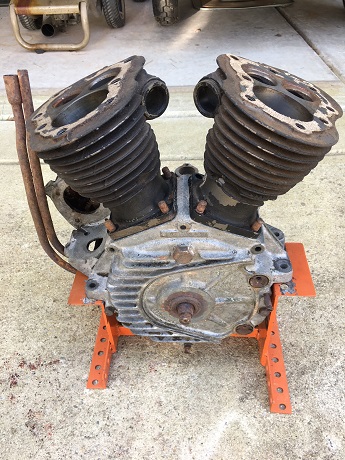
This was to keep water out of the motor when fording shallow rivers, and was standard issue on all Military 45 flatheads.
*********************
Related Articles:
Harley 45 Engine Teardown and Inspection
Harley 45 Engine Assembly
Harley 45 Timer And Ignition
Harley 45 Drivetrain
Harley 45 Frame Choices
